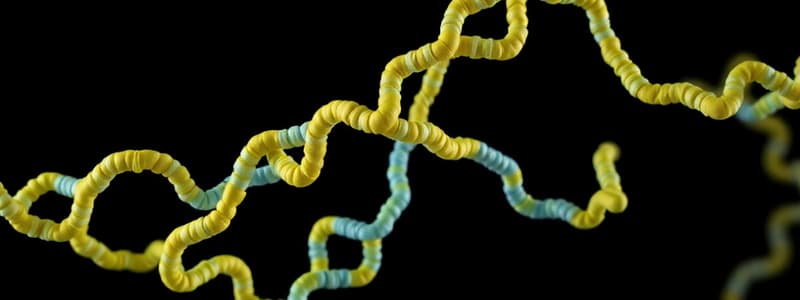Podcast
Questions and Answers
The basic building blocks of proteins are:
The basic building blocks of proteins are:
- Fatty acids
- Amino acids (correct)
- Monosaccharides
- Nucleotides
Which part of an amino acid varies between different amino acids?
Which part of an amino acid varies between different amino acids?
- Amino group
- Carboxyl group
- R-group (correct)
- Alpha carbon
A peptide bond is formed between which two groups?
A peptide bond is formed between which two groups?
- A phosphate group and a sugar
- A sugar and a base
- An amino group and a carboxyl group (correct)
- Two R-groups
An amino acid with a nonpolar side chain is:
An amino acid with a nonpolar side chain is:
An amino acid with a negatively charged side chain at physiological pH is:
An amino acid with a negatively charged side chain at physiological pH is:
Which amino acid can form disulfide bonds?
Which amino acid can form disulfide bonds?
Which amino acid's R-group forms a ring structure with its amino group?
Which amino acid's R-group forms a ring structure with its amino group?
The primary structure of a protein is its:
The primary structure of a protein is its:
Which type of bond stabilizes the primary structure of a protein?
Which type of bond stabilizes the primary structure of a protein?
Which of the following is a type of secondary protein structure?
Which of the following is a type of secondary protein structure?
Beta-pleated sheets are characterized by:
Beta-pleated sheets are characterized by:
The overall three-dimensional shape of a protein is its:
The overall three-dimensional shape of a protein is its:
A protein domain is:
A protein domain is:
Which type of interaction is NOT involved in stabilizing tertiary structure?
Which type of interaction is NOT involved in stabilizing tertiary structure?
The quaternary structure of a protein describes:
The quaternary structure of a protein describes:
Proteins that catalyze biological reactions are called:
Proteins that catalyze biological reactions are called:
Which of the following is NOT a function of proteins?
Which of the following is NOT a function of proteins?
Hemoglobin is classified as a:
Hemoglobin is classified as a:
The process of synthesizing RNA from a DNA template is called:
The process of synthesizing RNA from a DNA template is called:
In eukaryotes, transcription occurs in the:
In eukaryotes, transcription occurs in the:
Which of the following is a post-transcriptional modification in eukaryotes?
Which of the following is a post-transcriptional modification in eukaryotes?
The non-coding sequences within a gene are called:
The non-coding sequences within a gene are called:
The addition of a 5' cap and 3' poly-A tail to mRNA in eukaryotes helps with:
The addition of a 5' cap and 3' poly-A tail to mRNA in eukaryotes helps with:
The process of synthesizing a polypeptide chain from mRNA is called:
The process of synthesizing a polypeptide chain from mRNA is called:
Translation occurs at the:
Translation occurs at the:
Each codon on mRNA specifies a particular:
Each codon on mRNA specifies a particular:
A codon consists of how many nucleotides?
A codon consists of how many nucleotides?
The start codon AUG codes for the amino acid:
The start codon AUG codes for the amino acid:
Which site on the ribosome does the incoming aminoacyl-tRNA bind?
Which site on the ribosome does the incoming aminoacyl-tRNA bind?
The tRNA that carries the growing polypeptide chain is located in which site?
The tRNA that carries the growing polypeptide chain is located in which site?
Termination of translation occurs when a stop codon enters the:
Termination of translation occurs when a stop codon enters the:
A mutation that changes a single nucleotide and results in a different amino acid is a:
A mutation that changes a single nucleotide and results in a different amino acid is a:
Sickle cell anemia is caused by a mutation in the gene for:
Sickle cell anemia is caused by a mutation in the gene for:
Proteins that assist in the folding of other proteins are called:
Proteins that assist in the folding of other proteins are called:
Unfolding and disorganization of a protein's structure is called:
Unfolding and disorganization of a protein's structure is called:
Carbohydrates are composed of:
Carbohydrates are composed of:
Which of the following is a monosaccharide?
Which of the following is a monosaccharide?
Which of the following is a disaccharide?
Which of the following is a disaccharide?
Starch and glycogen are examples of:
Starch and glycogen are examples of:
The bond that links monosaccharides together is called a
The bond that links monosaccharides together is called a
The digestion of carbohydrates begins in the:
The digestion of carbohydrates begins in the:
Which enzyme initiates carbohydrate digestion in the mouth?
Which enzyme initiates carbohydrate digestion in the mouth?
Most carbohydrate digestion occurs in the:
Most carbohydrate digestion occurs in the:
The final digestion of carbohydrates into monosaccharides occurs at the:
The final digestion of carbohydrates into monosaccharides occurs at the:
Glucose is absorbed into enterocytes by:
Glucose is absorbed into enterocytes by:
Cellular reactions that break down molecules to release energy are called:
Cellular reactions that break down molecules to release energy are called:
The breakdown of glucose into pyruvate is called:
The breakdown of glucose into pyruvate is called:
Under anaerobic conditions, pyruvate is converted to:
Under anaerobic conditions, pyruvate is converted to:
The primary site of gluconeogenesis is the
The primary site of gluconeogenesis is the
Lipids are primarily composed of:
Lipids are primarily composed of:
Which of the following is a major function of lipids?
Which of the following is a major function of lipids?
Triacylglycerols consist of:
Triacylglycerols consist of:
Phospholipids are:
Phospholipids are:
Bile salts are synthesized from
Bile salts are synthesized from
The digestion of lipids primarily occurs in the:
The digestion of lipids primarily occurs in the:
Emulsification of lipids is accomplished by:
Emulsification of lipids is accomplished by:
The enzyme that digests triacylglycerols is:
The enzyme that digests triacylglycerols is:
The products of triacylglycerol digestion are:
The products of triacylglycerol digestion are:
Long-chain fatty acids are absorbed into the:
Long-chain fatty acids are absorbed into the:
The process of breaking down stored triglycerides is called:
The process of breaking down stored triglycerides is called:
Flashcards
Amino acids
Amino acids
The basic building blocks of proteins; they are linked together by peptide bonds to form polypeptide chains.
R-group
R-group
The specific part of an amino acid that differs in chemical structure and thus dictates specific properties of each of the 20 common amino acids.
Peptide bond
Peptide bond
A covalent chemical bond formed between two molecules when the carboxyl group of one molecule reacts with the amino group of the other molecule, releasing a molecule of water (H₂O).
Nonpolar amino acid
Nonpolar amino acid
Signup and view all the flashcards
Acidic amino acid
Acidic amino acid
Signup and view all the flashcards
Cysteine
Cysteine
Signup and view all the flashcards
Primary structure (protein)
Primary structure (protein)
Signup and view all the flashcards
Secondary structure (protein)
Secondary structure (protein)
Signup and view all the flashcards
Tertiary structure (protein)
Tertiary structure (protein)
Signup and view all the flashcards
Protein domain
Protein domain
Signup and view all the flashcards
Enzymes
Enzymes
Signup and view all the flashcards
Transport protein
Transport protein
Signup and view all the flashcards
Hemoglobin
Hemoglobin
Signup and view all the flashcards
Transcription
Transcription
Signup and view all the flashcards
Translation
Translation
Signup and view all the flashcards
Introns
Introns
Signup and view all the flashcards
Codon
Codon
Signup and view all the flashcards
Start codon
Start codon
Signup and view all the flashcards
Chaperones
Chaperones
Signup and view all the flashcards
Protein denaturation
Protein denaturation
Signup and view all the flashcards
Study Notes
Protein Structure and Amino Acids
- Amino acids are the fundamental components of proteins.
- The R-group is the portion of an amino acid that distinguishes it from others.
- A peptide bond forms between an amino group and a carboxyl group.
- An example of an amino acid featuring a nonpolar side chain is valine.
- Aspartic acid is an amino acid that has negatively charged side chain at physiological pH.
- Cysteine is the amino acid capable of forming disulfide bonds.
- Proline is the amino acid with an R-group that creates a ring structure with its amino group.
- The primary structure of a protein is its amino acid sequence.
- Peptide bonds stabilize the primary structure of proteins.
- An alpha-helix is a type of secondary protein.
- Beta-pleated sheets have a zigzag arrangement of polypeptide chains.
- The overall three-dimensional shape of a protein signifies its tertiary structure.
- A protein domain is a distinct structural unit of a polypeptide.
- Peptide bonds are not involved in stabilizing tertiary structure.
- The quaternary structure refers to the arrangement of subunits.
Protein Function and Synthesis
- Enzymes catalyze biological reactions.
- Energy storage is not a function of proteins.
- Hemoglobin functions as a transport protein.
- Transcription synthesizes RNA from a DNA template.
- In eukaryotes, transcription occurs in the nucleus.
- RNA splicing is a post-transcriptional modification in eukaryotes.
- Introns are non-coding sequences within a gene.
- The 5' cap and 3' poly-A tail enhance eukaryotic mRNA stability and translation.
- Translation synthesizes a polypeptide chain from mRNA.
- Translation occurs at the ribosome.
- A codon on mRNA specifies an amino acid.
- A codon comprises three nucleotides.
- Methionine is coded for by the start codon AUG.
- Incoming aminoacyl-tRNA binds to the A-site on the ribosome.
- The tRNA that carries the expanding polypeptide chain is located at the P-site.
- Translation terminates when a stop codon occupies the A-site.
Protein Mutations and Misfolding
- A missense mutation changes a single nucleotide, leading to a different amino acid.
- Sickle cell anemia results from a mutation in the beta-globin gene.
- Chaperones are proteins that aid in the folding process of other proteins.
- Protein denaturation is the unfolding and disorganization of a protein's structure.
Carbohydrate Structure and Classification
- Monosaccharides compose carbohydrates.
- Glucose is a monosaccharide.
- Sucrose is a disaccharide.
- Starch and glycogen are polysaccharides.
- A glycosidic bond links monosaccharides.
Carbohydrate Digestion and Metabolism
- Carbohydrate digestion starts in the mouth.
- Salivary amylase (ptyalin) starts carbohydrate digestion in the mouth.
- Most carbohydrate digestion occurs in the small intestine.
- The intestinal brush border facilitates the final digestion of carbohydrates into monosaccharides.
- Facilitated diffusion and active transport absorb the glucose into enterocytes.
- Catabolic reactions break down molecules, releasing energy.
- Glycolysis is the breakdown of glucose into pyruvate.
- Lactate is what pyruvate is converted to under anaerobic conditions.
- The liver is the primary site of gluconeogenesis.
Lipid Structure and Function
- Fatty acids are the primary components of lipids.
- Energy storage is a major function of lipids.
- Triacylglycerols consist of glycerol and three fatty acids.
- Phospholipids consist of glycerol, two fatty acids, a phosphate group, and a polar head.
- Cholesterol synthesizes bile salts.
Lipid Digestion and Metabolism
- Lipid digestion primarily occurs in the small intestine.
- Bile salts accomplish the emulsification of lipids.
- Lipase digests triacylglycerols.
- Monoglycerides and fatty acids are the products of triacylglycerol digestion.
- The lymphatic system absorbs long-chain fatty acids.
- Lipolysis is the breakdown of stored triglycerides.
Studying That Suits You
Use AI to generate personalized quizzes and flashcards to suit your learning preferences.




